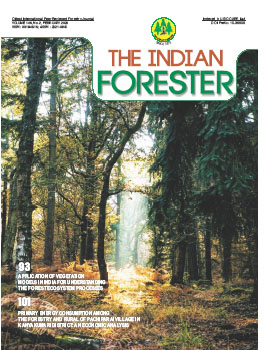A Short Survey for New Hosts of Helicanthes elastica (Desr.) Danser and its Morphological Diversity on Selected Hosts
DOI:
https://doi.org/10.36808/if/2020/v146i2/151211Keywords:
Helicanthes elastica, Loranthaceae, Epicortical Roots, Haustoria, Bark.Abstract
Helicanthes elastica a common Loranthacean parasite abundantly grows on many trees ofurban areas. The survey for new hosts revealed that apart from angiosperm hosts the parasite started invading gymnosperms trees too. The growth pattern of this parasite found varied among selected hosts. The bark characteristics and peripheral tissue system ofhosts determine the pattern growth ofH.elastica on them. The quantitative morphological features found not altered much by the influence ofhosts but the other characters like spreading ofepicortical runners, branching o f haustoria and its penetration into the host found altered due to the effect ofhost trees.References
Gamble J.S. (1967). The Flora of the Presidency of Madras. (II reprinted edition) l-lll. Botanical Survey of India, Culcutta: 873-878.
Gill L.S. and Hawksworth F.G. (1961). The mistletoes. A literature review. Technical bulletin No.1242. United States. Department of Agriculture, Washington DC.
Mehrotra R.S. and Ashok Aggarwal. (2003). Plant pathology 2nd Edn. Tata Me Graw Hill publishing company ltd. In. diseases due to angiospermic parasites: 782 pp.
Nayar T.S., Rasiya Beegum A., Mohanan N., Rajkumar G. and Sibi M. (2006). Flowering plants of Kerala: A handbook. Tropical botanic garden and research institute, Palode, Thiruvananthapuram: 387-388.
Sasidharan N. and Sivarajan V.V. (1996). Flowering plants of Thrissur forest (Western ghats, Kerala, India). Scientific publishers. Jodhpur: 385 pp.
Scot G.J. (1871). Loranthaceae-the mistletoe order germination and mode of attachment. J. Agri. Hort. Soc. India. 2: 257 pp.
Shanavaskhan A.E. and Sivadasan M. (2009). Epiphytesand parasites of Kerala India, 1st ed; Bihen Singh Mahendrapal Singh, Dehradun: 213-272.
Singh B. (1954). Studies in the family Loranthaceae. List of new hosts of Dendrophthoe falcata (L. f.) Ettings, its relations with hosts, the anatomy of its seedling and mature haustorium. Agra Univ. Jour. Res., 3(2): 301-315
Sunil Kumar K.N., Saraswathy A. and Amerjothy S. (2015A). Survey report on hosts and haustoria of Helicanthes elastica (Desr.) Danser in Udupi and Dakshina Kannada districts of Karnataka and Kasargod district of Kerala, India - A concise review plus some new additions. Indian Forester, 141(4): 448-451.
Sunil KumarK.N., Shakila P., Balakrishna K. and Amerjothy S. (2015B). Phytochemical examination of compounds from mango mistletoe - Helicanthes elastica (Desr.) Danser. Indian Jouranl ofChemistry. 54B: 924-929.
Downloads
Downloads
Published
How to Cite
Issue
Section
License
Unless otherwise stated, copyright or similar rights in all materials presented on the site, including graphical images, are owned by Indian Forester.





